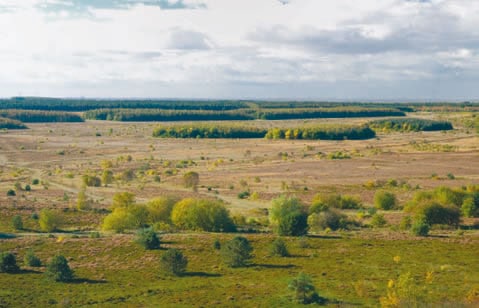- Host
- News
- Sport, Active & Thalasso
- Discover & Experience
- Good to know
- Sustainability
 Beach and mudflats have made Cuxhaven famous. But have you already discovered the coastal heath for yourself? This incredibly beautiful stretch of land stretches from Duhnen to Oxstedt in the south. Large areas of Cuxhaven's coastal heath with its valuable flora and fauna are nature reserves of international importance.
Beach and mudflats have made Cuxhaven famous. But have you already discovered the coastal heath for yourself? This incredibly beautiful stretch of land stretches from Duhnen to Oxstedt in the south. Large areas of Cuxhaven's coastal heath with its valuable flora and fauna are nature reserves of international importance.
 The Cuxhaven coastal heath is the largest contiguous area of heath on the mainland of the German North Sea coast. Directly behind the Geest, a mosaic of extensive heaths, rough grasslands, small heather moors and oak-crested forests extends close to the coast. Many dwarf shrubs grow here, such as crowberry and bell heather.
The Cuxhaven coastal heath is the largest contiguous area of heath on the mainland of the German North Sea coast. Directly behind the Geest, a mosaic of extensive heaths, rough grasslands, small heather moors and oak-crested forests extends close to the coast. Many dwarf shrubs grow here, such as crowberry and bell heather.
The large-scale expansion of the moors only began in the Middle Ages. The high demand for wood for dyke and ship building as well as settlement in the wood-poor marshes, "eternal rye cultivation" and the effects of the existing feudal system caused the large-scale desertification of the landscape.
Nowadays, grazing animals help to maintain the heaths by pushing back the scrub:
A signposted network of paths with information boards, observation platforms and nature trails leads through Cuxhaven's diverse coastal heath landscape. Beach and mudflats have made Cuxhaven famous. But have you already discovered the coastal heath for yourself? This incredibly beautiful stretch of land stretches from Duhnen to Oxstedt in the south. Large areas of the Cuxhaven coastal heath with its valuable flora and fauna are nature reserves of international importance.
The Cuxhaven coastal heath is the largest contiguous area of heath on the mainland of the German North Sea coast. Directly behind the Geest, a mosaic of extensive heaths, rough grasslands, small heather moors and oak-crested forests extends close to the coast. Many dwarf shrubs grow here, such as crowberry and bell heather.
The large-scale expansion of the moors only began in the Middle Ages. The high demand for wood for dyke and ship building as well as settlement in the wood-poor marshes, "eternal rye cultivation" and the effects of the existing feudal system caused the large-scale desertification of the landscape.
Nowadays, grazing animals help to maintain the heaths by pushing back the scrub:
A signposted network of paths with information boards, observation platforms and nature trails leads through Cuxhaven's diverse coastal heathland landscape.